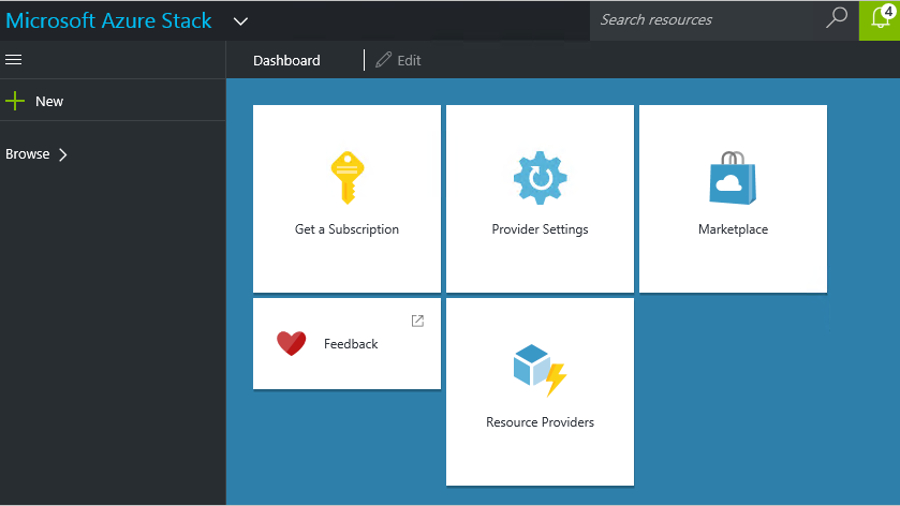Azure Stack isn't Microsoft backing away from public cloud
Azure Stack is designed to help customers get ready for public cloud

For the last few years, Microsoft has been calling itself a cloud-first (and mobile-first) company and talking up its hyperscale Azure cloud – so why is it coming out with Azure Stack, a private cloud system?
Because hybrid cloud is what customers want, and ironically, having it will actually get more businesses using public cloud because of the consistency and the ecosystem that will develop around that, says Mike Neil, Microsoft VP for enterprise cloud.
Stepping stone
The reason Microsoft is creating Azure Stack isn't any lack of confidence in public cloud – it's because customers are demanding it as a stepping stone. Neil suggests viewing Azure Stack not as a separate product but as a feature of the Azure cloud.
"It checks the checkbox that says hybrid and allows the customer to make that choice, of being able to run in the public cloud or private cloud. For a lot of customers today, they tell us 'you're knocking down the security issues [I was concerned about], you're knocking down a bunch of compliance issues, you've got the capabilities that I want but I'm still uncomfortable that I have to put everything in your cloud'. This gives them the option to have on-premise control."
That will help public Azure grow, he believes. "If that's the blocking issue for a customer adopting Azure in the broad sense – not just public Azure but Azure on-premise – then we expect that to accelerate adoption."
Standing out from the cloud
Plus, it helps Microsoft stand out from Amazon and Google and other cloud providers, so Azure can reach customers who need more than public cloud. Neil states: "It's a key differentiator for us – if you look at the competition like AWS, it doesn't have anything like this. For customers who want to have that flexibility and control in their on-premise environment rather than just in the public environment, it's a unique offering.
"If your mantra is public cloud, public cloud, public cloud, and that's it, then you've got this myopic view of the world that doesn't match a lot of customers. I know very few customers who are 100% cloud and expect to be 100% cloud."
Sign up to the TechRadar Pro newsletter to get all the top news, opinion, features and guidance your business needs to succeed!
Azure Stack isn't Azure
The key technology in Azure Stack comes from what runs the public Azure cloud, but businesses need to be clear that running their own version of Azure doesn't get them the scale and savings of public cloud. "We'll have to be very clear with customers so they understand the scale limitations and the performance limitations of running Azure in their data centre."
Some parts of the experience will be the same. "We want the functionality, the top level APIs and the way they experience the portal to mimic Azure as closely as possible," explains Neil. "But the challenge we have – a minimum stamp size for public Azure is about 1,000 machines. How do we take that technology and scale it down to something that's more cost-effective at the entry price option for customers and make that a usable system?"
Hybrid cloud isn't well understood, he admits. "Cloud is relatively new to the market. Hybrid is another term that's been used for a while and it has gotten deformed by various competitors who try to bend that to mean what they have.
"In my mind, and I hope in the customer's mind, hybrid means I can run in the on-premise environment and in the public environment, and that public environment might be a public environment like Azure or that public environment might be other hosting providers, service providers.
"As opposed to 'I can back up your data on-premise' or 'I can Active Directory federate with you' or something like that. We need to set that expectation with customers that hybrid really does mean the flexibility of running workloads in either location, because cloud is not a location, it's a mind-set, and we want to make location an option for customers."
- 1
- 2
Current page: Introduction and positioning of Azure Stack
Next Page Customer choice and cloud burstingMary (Twitter, Google+, website) started her career at Future Publishing, saw the AOL meltdown first hand the first time around when she ran the AOL UK computing channel, and she's been a freelance tech writer for over a decade. She's used every version of Windows and Office released, and every smartphone too, but she's still looking for the perfect tablet. Yes, she really does have USB earrings.